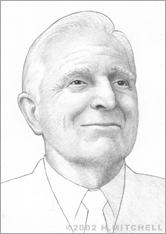Doug Engelbart
Years before personal computers and desktop information processing became commonplace or even practicable, Douglas Carl Engelbart had invented a number of interactive, user-friendly information access systems that we take for granted today: the computer mouse, windows, shared-screen teleconferencing, hypermedia, groupware, and more.
Born in 1925, Engelbart grew up during the Great Depression near Portland, Oregon. He finished high school in 1942 and then studied electrical engineering at Oregon State University. During World War II, he took a break from his studies to serve in the Navy, which sent him to the Philippines for two years as an electronic/radar technician. In 1948, he received his BS degree in electrical engineering and went to work for NACA Ames Laboratory (forerunner of NASA). He then applied to the graduate program in electrical engineering at the University of California, Berkeley and obtained his PhD in 1955. He stayed on at Berkeley as an acting assistant professor, but a year later, he left to work for Stanford Research Institute, or SRI Intl.
At SRI, Engelbart earned a dozen patents in two years, working on magnetic computer components, fundamental digital-device phenomena, and miniaturization scaling potential. In 1962, he published his seminal work, "Augmenting Human Intellect: A Conceptual Framework," under contract prepared for the Director of Information Sciences of the U.S. Air Force Office of Scientific Research. This outlined his visionary ideas for using computers to complement humans’ intelligence. Many shrugged his ideas off at the time. It was difficult for many people to grasp what Engelbart envisioned because the concepts were too futuristic.
At the Fall Joint Computer Conference in San Francisco in 1968, Engelbart astonished his colleagues by demonstrating a computer system called NLS (oNLine System) using a “primitive” 192-kilobyte mainframe computer located 25 miles away to demonstrate hypermedia, on-screen video teleconferencing, and a device he called an "X-Y Position Indicator for a Display System.” This device would later become known worldwide as the indispensible computer mouse. Engelbart’s presentation at the conference was met with a standing ovation.
Now, years later, his inventions have been integrated into mainstream computing as industry capabilities have increased. It was not until 1984 that the Apple Macintosh popularized the mouse, but today it is difficult to imagine a personal computer without one. The huge success of Microsoft's Windows system proves that Engelbart's original windows concept has also become a virtual necessity.
Engelbart continued to direct SRI’s Augmentation Research Center until 1978 when the lab was closed down due to a lack of funding. NLS then became the principal line of business in Tymshare's Office Automation Division under the name Augment. In 1984, Tymshare was acquired by McDonnell Douglas Corporation, which terminated Engelbart's laboratory in 1989. That year, Engelbart founded the Bootstrap Institute in Palo Alto, Calif. with his daughter. He devoted his time to R&D, consulting, publications, speaking engagements, seminars, and workshops, and he worked with a team of volunteers to design a prototype open-hyperdocument system (OHS), which he hoped may one day replace paper record-keeping entirely.
Engelbart authored over 25 publications, earned more than 20 patents, and received many honors, including the 1997 Lemelson-MIT Prize. In 2000, he was awarded the National Medal of Technology from President Clinton. In a talk delivered at the Massachusetts Institute of Technology in 1996, Bill Gates praised Engelbart for his pioneering work. An article honoring the 20 persons who have had the greatest impact on personal computing, published in the September 1995 issue of Byte magazine, compared Engelbart to Thomas Edison.
Engelbart died on July 2, 2013.


